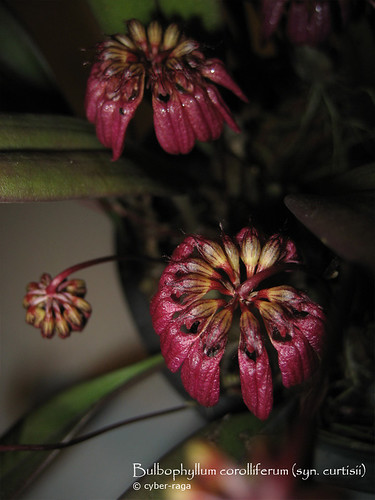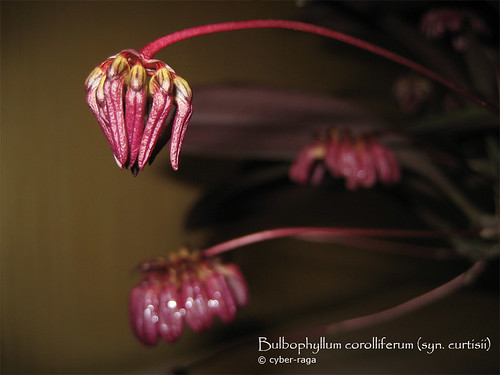J.J.Sm. 1917 Section Cirrhopetalum
 |
| Plant: Overall View |
Previously in December 2010, I had a post on 'Bulbophyllum curtisii var. lutescens' that has yellow flower. Further to that, I wish to share photos of Bulbophyllum corolliferum (syn. curtisii) that has the typical color form of purplish flower as compared to that of the former.
Bulbophyllum corolliferum is a lowland hot-warm growing orchid species that ranges from Thailand and Malaysia. The flowering period in Thailand is between November to December. It can have up to 10 flowers arranged in umbel. The size of each flower is about 0.3cm wide x 1.5 cm in length.
 |
| Plant: Another View |
Like most bulbophyllum, it prefers bright and damp condition but not under direct sunlight. It has fine roots that should not be subjected to long period of 'wet feet' between waterings, as this could leads to root rot.
Often if the orchid is well grown, it will tends to send out their rhizomes to cover the entire pot or slab, and eventually its pseudobulbs will hang out of the media (It's time for repot!). The bulbophyllum shown here is a good example of a well established plant.
 |
| Flower: Top View |
The featured Bulbophyllum corolliferum belongs to my friend, Winston. The photo of his plant were taken impromptu during OSSEA Monthly Meeting in February this year. This floriferous bulbophyllum and all of his orchids (Vandas, Dendrobium and etc) are grown outdoor under the shade of trellises at his landed house. He have been feeding his orchids with organic fertilizer weakly weekly. The overall microclimate in his garden is warm and breezy with high humidity aided by water sprinkler system.
In my point of view, I find the flower of this particular bulbophyllum have a rather intense dark shade of reddish purple lateral sepal and distinct stripes on its dorsal sepal. What a beauty!
 |
| Flower: Close-up |
 |
| Flower: Close-up of red vein-like markings on dorsal sepal |
 |
| Flower: Budding |



No comments:
Post a Comment